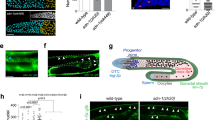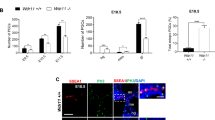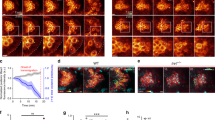Abstract
Germ cells preserve an individual's genetic information and transmit it to the next generation. Early in development germ cells are set aside and undergo a specialized developmental programme, a hallmark of which is the migration from their site of origin to the future gonad1. In Drosophila, several factors have been identified that control germ-cell migration to their target tissues2,3,4; however, the germ-cell chemoattractant or its receptor have remained unknown. Here we apply genetics and in vivo imaging to show that odysseus, a zebrafish homologue of the G-protein-coupled chemokine receptor Cxcr4, is required specifically in germ cells for their chemotaxis. odysseus mutant germ cells are able to activate the migratory programme, but fail to undergo directed migration towards their target tissue, resulting in randomly dispersed germ cells. SDF-1, the presumptive cognate ligand for Cxcr4, shows a similar loss-of-function phenotype and can recruit germ cells to ectopic sites in the embryo, thus identifying a vertebrate ligand–receptor pair guiding migratory germ cells at all stages of migration towards their target.
This is a preview of subscription content, access via your institution
Access options
Subscribe to this journal
Receive 51 print issues and online access
$199.00 per year
only $3.90 per issue
Buy this article
- Purchase on Springer Link
- Instant access to full article PDF
Prices may be subject to local taxes which are calculated during checkout




Similar content being viewed by others
References
Wylie, C. Germ cells. Cell 96, 165–174 (1999)
Starz-Gaiano, M., Cho, N. K., Forbes, A. & Lehmann, R. Spatially restricted activity of a Drosophila lipid phosphatase guides migrating germ cells. Development 128, 983–991 (2001)
Van Doren, M., Broihier, H. T., Moore, L. A. & Lehmann, R. HMG-CoA reductase guides migrating primordial germ cells. Nature 396, 466–469 (1998)
Zhang, N., Zhang, J., Purcell, K. J., Cheng, Y. & Howard, K. The Drosophila protein Wunen repels migrating germ cells. Nature 385, 64–67 (1997)
Knaut, H., Pelegri, F., Bohmann, K., Schwarz, H. & Nusslein-Volhard, C. Zebrafish vasa RNA but not its protein is a component of the germ plasm and segregates asymmetrically before germline specification. J. Cell Biol. 149, 875–888 (2000)
Yoon, C., Kawakami, K. & Hopkins, N. Zebrafish vasa homologue RNA is localized to the cleavage planes of 2- and 4-cell-stage embryos and is expressed in the primordial germ cells. Development 124, 3157–3165 (1997)
Olsen, L. C., Aasland, R. & Fjose, A. A vasa-like gene in zebrafish identifies putative primordial germ cells. Mech. Dev. 66, 95–105 (1997)
Weidinger, G. et al. Regulation of zebrafish primordial germ cell migration by attraction towards an intermediate target. Development 129, 25–36 (2002)
Knaut, H., Steinbeisser, H., Schwarz, H. & Nusslein-Volhard, C. An evolutionary conserved region in the vasa 3′UTR targets RNA translation to the germ cells in the zebrafish. Curr. Biol. 12, 454–466 (2002)
Chung, C. Y., Potikyan, G. & Firtel, R. A. Control of cell polarity and chemotaxis by Akt/PKB and PI3 kinase through the regulation of PAKa. Mol. Cell 7, 937–947 (2001)
Iijima, M., Huang, Y. E. & Devreotes, P. Temporal and spatial regulation of chemotaxis. Dev. Cell 3, 469–478 (2002)
Meili, R. et al. Chemoattractant-mediated transient activation and membrane localization of Akt/PKB is required for efficient chemotaxis to cAMP in Dictyostelium. EMBO J. 18, 2092–2105 (1999)
Parent, C. A., Blacklock, B. J., Froehlich, W. M., Murphy, D. B. & Devreotes, P. N. G protein signaling events are activated at the leading edge of chemotactic cells. Cell 95, 81–91 (1998)
Wess, J. G-protein-coupled receptors: molecular mechanisms involved in receptor activation and selectivity of G-protein recognition. FASEB J. 11, 346–354 (1997)
Chong, S. W., Emelyanov, A., Gong, Z. & Korzh, V. Expression pattern of two zebrafish genes, cxcr4a and cxcr4b. Mech. Dev. 109, 347–354 (2001)
Wolke, U., Weidinger, G., Koprunner, M. & Raz, E. Multiple levels of posttranscriptional control lead to germ line-specific gene expression in the zebrafish. Curr. Biol. 12, 289–294 (2002)
Horuk, R. Chemokine receptors. Cytokine Growth Factor Rev. 12, 313–335 (2001)
Feng, Y., Broder, C. C., Kennedy, P. E. & Berger, E. A. HIV-1 entry cofactor: functional cDNA cloning of a seven-transmembrane, G protein-coupled receptor. Science 272, 872–877 (1996)
Zou, Y. R., Kottmann, A. H., Kuroda, M., Taniuchi, I. & Littman, D. R. Function of the chemokine receptor CXCR4 in haematopoiesis and in cerebellar development. Nature 393, 595–599 (1998)
Tachibana, K. et al. The chemokine receptor CXCR4 is essential for vascularization of the gastrointestinal tract. Nature 393, 591–594 (1998)
Bleul, C. C. et al. The lymphocyte chemoattractant SDF-1 is a ligand for LESTR/fusin and blocks HIV-1 entry. Nature 382, 829–833 (1996)
Oberlin, E. et al. The CXC chemokine SDF-1 is the ligand for LESTR/fusin and prevents infection by T-cell-line-adapted HIV-1. Nature 382, 833–835 (1996)
Nagasawa, T. et al. Defects of B-cell lymphopoiesis and bone-marrow myelopoiesis in mice lacking the CXC chemokine PBSF/SDF-1. Nature 382, 635–638 (1996)
Zhu, Y. et al. Role of the chemokine SDF-1 as the meningeal attractant for embryonic cerebellar neurons. Nature Neurosci. 5, 719–720 (2002)
Acknowledgements
We thank F. Schnorrer for discussions and critical comments on the manuscript. The PH–GFP fusion protein was a gift from M. Landree and P. Devreotes. H.K. was in part supported by a Boehringer Ingelheim predoctoral fellowship. R.G. was supported by the German Human Genome Project (DHGP). This work was supported by the Max-Planck Gesellschaft. Publication costs were in part defrayed by the Fonds der Chemischen Industrie.
Author information
Authors and Affiliations
Consortia
Corresponding author
Ethics declarations
Competing interests
The authors declare that they have no competing financial interests.
Rights and permissions
About this article
Cite this article
Knaut, H., Werz, C., Geisler, R. et al. A zebrafish homologue of the chemokine receptor Cxcr4 is a germ-cell guidance receptor. Nature 421, 279–282 (2003). https://doi.org/10.1038/nature01338
Received:
Accepted:
Published:
Issue Date:
DOI: https://doi.org/10.1038/nature01338
This article is cited by
-
Neuronal chemokine concentration gradients mediate effects of embryonic ethanol exposure on ectopic hypocretin/orexin neurons and behavior in zebrafish
Scientific Reports (2023)
-
Induced formation of primordial germ cells from zebrafish blastomeres by germplasm factors
Nature Communications (2023)
-
Rear traction forces drive adherent tissue migration in vivo
Nature Cell Biology (2022)
-
Recapitulation of normal collagen architecture in embryonic wounded corneas
Scientific Reports (2020)
-
A negative-feedback loop maintains optimal chemokine concentrations for directional cell migration
Nature Cell Biology (2020)
Comments
By submitting a comment you agree to abide by our Terms and Community Guidelines. If you find something abusive or that does not comply with our terms or guidelines please flag it as inappropriate.



